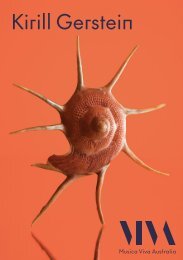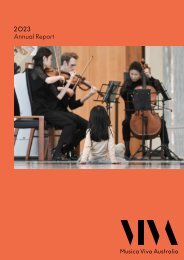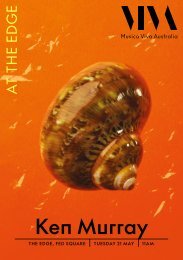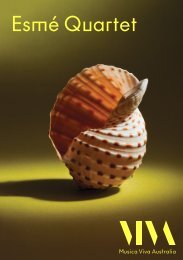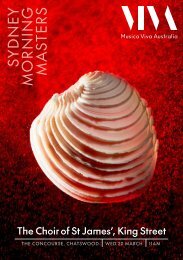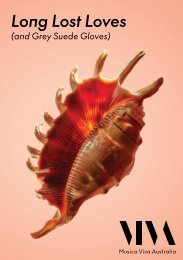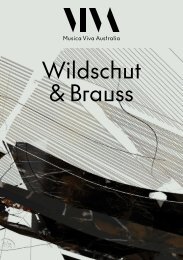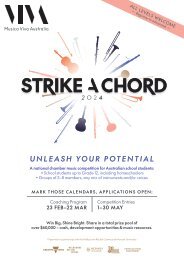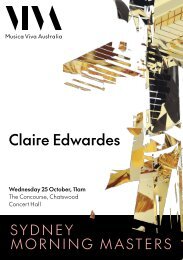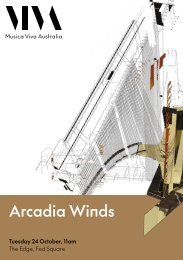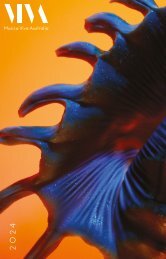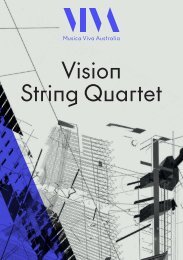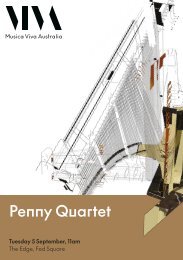Avi Avital & Erin Helyard Program Guide | September 2022
You also want an ePaper? Increase the reach of your titles
YUMPU automatically turns print PDFs into web optimized ePapers that Google loves.
Three works by Giovanni Sollima himself are<br />
next up; the cellist balances his performing<br />
life with that of a composer. The first of these<br />
works is literally an Improvisation, drawing<br />
on themes or fragments from traditional<br />
tunes (from Sicily, the Balkans etc), or from<br />
his own works, or from Bach’s Cello Suites...<br />
Sollima describes it ‘a surprise moment in the<br />
program’.<br />
Federico II is a piece originally written for<br />
string quartet as part of a 2001 project called<br />
Viaggio in Italia (Italian Journey): one hour<br />
of music for quartet/quintet and voice which<br />
premiered at Carnegie Hall in New York.<br />
Federico II is inspired by the controversial<br />
13th-century figure of Friedrich Hohenstaufen<br />
– Federico Ruggero in his native Italy – who<br />
was King of Sicily (from the age of three!),<br />
King of Jerusalem and Holy Roman Emperor,<br />
ruling over a vast empire that stretched<br />
through Italy, all the way north to Germany.<br />
He lies buried in Palermo Cathedral. On the<br />
one hand, he was a major patron of science<br />
and the arts, a scholar, poet, composer and<br />
architect (some of his buildings are truly<br />
amazing, and many are still open today);<br />
on the other, Dante Alighieri in the Divine<br />
Comedy places him in Hell.<br />
Alep (Pesce) is also born from a larger-scale<br />
project. Sollima describes it as ‘essentially a<br />
song, in an antique or folk style. Leonardo’s<br />
Bestiary is a text that I love very much by<br />
Leonardo da Vinci who, among all his codices,<br />
discoveries, experiments, inventions and<br />
paintings, had the time to write musical jokes,<br />
rebus puzzles and games. The Bestiary is a<br />
catalogue of animals, real and imaginary:<br />
Leonardo gives them names – Alep is a fish –<br />
and human characters, both the virtues and<br />
the vices...’.<br />
Dario Castello (1602–1631) worked mostly in<br />
Venice: he held a position as violinist at<br />
St Mark’s Basilica under Claudio Monteverdi.<br />
His Sonata is followed by a Tarantella by<br />
Sollima’s father, also a composer:<br />
Eliodoro Sollima (1926–2000).<br />
<strong>Avi</strong> <strong>Avi</strong>tal’s own thrilling arrangement of a<br />
traditional Bulgarian tune may be familiar<br />
to listeners who have attended his Musica<br />
Viva Australia concerts previously – back<br />
by popular demand! Girolamo Frescobaldi<br />
(1583–1643), meanwhile, was a highly<br />
influential Italian composer of mostly keyboard<br />
music; he held the position of organist of<br />
St Peter’s Basilica.<br />
Concluding the program are two more folk<br />
tunes; one Sephardic and one from Salento<br />
(in the ‘heel’ of the Italian ‘boot’).<br />
|<br />
11<br />
|<br />
1. Iberian Peninsula | Traditional Sephardic<br />
2. Turkey | Traditional Turkish<br />
3. Macedonia | Traditional Macedonian<br />
4. Naples, Italy | Domenico Scarlatti’s birthplace<br />
5. Palermo, Sicily | Giovanni Sollima’s birthplace<br />
6. Venice, Italy | Castello – Sonata No. 4<br />
7. Marsala, Sicily | Eliodoro Sollima’s birthplace<br />
8. Bulgaria | Bučimiš<br />
9. St Peter’s Basilica, Vatican City | Frescobaldi<br />
– Canzona No. 3<br />
10. Salento, Italy | Traditional Salento<br />
11. Be’er Sheva, Israel | <strong>Avi</strong> <strong>Avi</strong>tal’s birthplace




